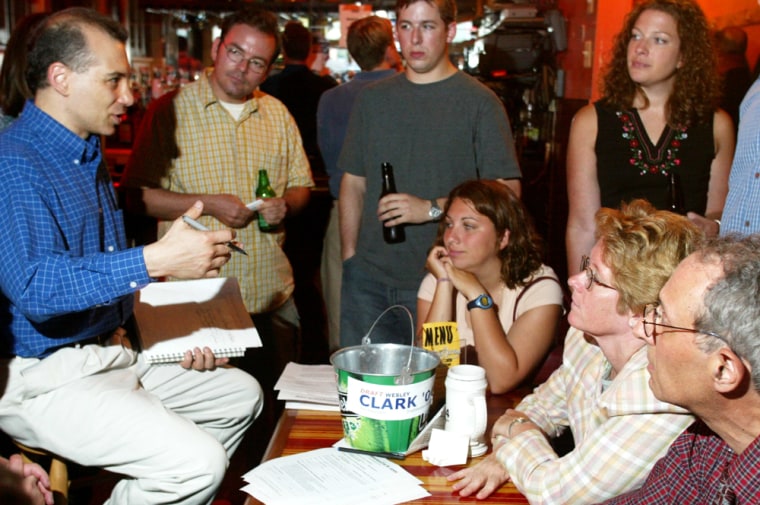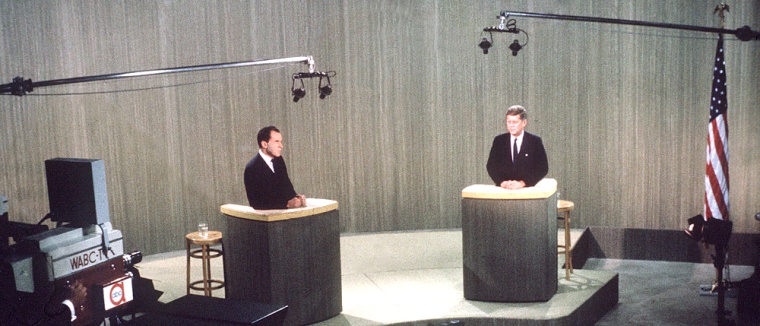This is the year that the old model of running a presidential campaign and reporting on one may finally have been discarded, for better or worse.
The mainstream news media and the traditional rituals for candidates — rallies, speeches, town hall-style meetings before sympathetic audiences — are increasingly being outflanked or overshadowed by unconventional outsiders.
From muckraking author Kitty Kelley, whose new book on the Bush family was published this week, to director Michael Moore and his anti-Bush film "Fahrenheit 9/11," to blogs such as Powerline.com and indcjournal.com, who challenged the authenticity of documents that CBS News said proved Bush had shirked his National Guard duty 32 years ago, outside agents are now wielding the power to pull control of the campaign away from the campaign managers and the traditional news media.
In the old model of presidential campaigns, the rules were clear:
- The mainstream media — the New York Times, the Washington Post, the wire services, the three broadcast television networks — were the principal sources of information for most voters.
- Candidates communicated to voters on broadcast television through advertising.
- Candidates met in televised debates and stuck to a gentlemanly, serious discussion of foreign policy and domestic issues.
- The personal lives of candidates — marital infidelity, illicit drug use — and their actions as young men were not thought to be an appropriate or relevant subject for news media coverage.
Presidential campaigns were very much top-down operations with the important decisions made by a candidate and a half-dozen or so of his advisers.
Reading Theodore H. White’s classic “The Making of a President 1960” from the perspective of a 2004 campaign style, the most striking thing about 1960 was that the power to make decisions affecting the course of the race was concentrated in the hands of candidates Richard Nixon and John Kennedy, their top strategists such as Kenneth O’Donnell for Kennedy, and the incumbent president, Dwight Eisenhower
In 1960, no one could start a political blog and second guess the strategies of the campaigns or the media coverage of them.
Now the barriers to entry have been dramatically lowered, opening the way to a do-it-yourself kind of politics.
Two defining phenomena
To see how much the battlefield has shifted and the tactics have changed, consider two of the 2004 campaign’s defining phenomena.
In local Meetup.com gatherings, in spring and summer of 2003, Howard Dean enthusiasts found each other and began building a grass-roots organization for a small-state governor who few political reporters thought had a chance of being a genuine contender for the Democratic nomination. They came pretty close to pulling off a political marvel.

Meanwhile, the Draft Wesley Clark movement was launched by newcomers whom inside-the- Beltway operatives hadn’t heard of: John Hlinko, Chris Kofinis and Josh Margulies.
Hlinko, Kofinis and Margulies had the insight to see the post-Sept. 11 wisdom of the Democratic Party nominating the kind of Democrat that no Republican consultant had experience running against, a four-star general.
They got the bandwagon rolling with a Web site, energetic self-promotion, and an ultra-low budget TV ad campaign.
Kofinis, who is now a strategist with theNaderFactor.com, an effort to persuade anti-Bush voters to not vote for Nader, assessed the new landscape by saying, “What's going on here is the new age of Media politics — because of the Internet, the 24/7 news cycle, and the ability of average voters to gather information on second-to-second basis.”
Kofinis said, "You have the ability to influence public opinion dramatically and immediately, an ability to create political events or movements almost immediately. This new media age in elections does change the face of the game; it now allows a plethora of new actors — for good and bad — to influence public opinion."
The change affects both those who make the news and those who report it. As the traditional TV news broadcasts have lost some of their clout, candidates have taken to new venues in an attempt to reach harried, information-saturated voters.
The lighter side
John Kerry appeared on Jon Stewart’s "The Daily Show" on the Comedy Channel, not to discuss any issues such as Social Security but to let viewers see the more casual side of his personality.
When President Bush wanted to repair some of the damage from one of his gaffes about America not being able to win the war against terrorists, he chose a non-adversarial, non-traditional venue, Rush Limbaugh’s radio show.
While continuing to bombard viewers with old-style TV ads, the campaigns have turned to their own Web sites to augment their propaganda efforts, speaking not so much to the uncommitted voter who makes a last-minute decision as to partisans.
In June for instance, on its Web site, the Bush-Cheney campaign offered a video called "Kerry's Coalition of the Wild-eyed" to put on display “the pessimism and rage of John Kerry and his fellow Democrats.” It featured clips of Dean shouting, “I want my country back!" and Al Gore attacking Bush saying, “He betrayed this country! He played on our fears!"
At the same time, a range of outside groups have allowed adversaries of Bush or of Kerry to broaden the field of fire, using harder-hitting messages than the candidates themselves use about each other.
A potent voice
Moveon.org has become a potent, independent advertising and fund-raising voice on the left wing of the Democratic Party. Some of its most eye-catching ads, such as one showing the Statue of Liberty hooded as were some Abu Ghraib prisoners, would be too inflammatory for the Kerry campaign to run, but serve to convey the larger message of the anti-Bush crusade.
John O’Neill and the "Swift Boat Veterans for Truth," through their best-selling book and the TV ads, have put Kerry on the defensive, leading him to consume precious campaigning time defending his service as a Navy officer in Vietnam and his anti-war testimony to the Senate Foreign Relations Committee in 1971.
The first Swift Boat TV ad was perhaps the most cost-effective effort in modern political history.
There were only 739 airings of the ad out of more than 500,000 presidential campaign spots broadcast from March 3 to the end of August, according to Nielsen Monitor-Plus and the University of Wisconsin Advertising Project.
But due to the nature of their accusations, the Swift Boat Veterans got huge free media play, which means that anyone with an interest in the campaign has seen them.
If Theodore H. White or the men who ran the 1960 presidential campaigns were to come back and see the 2004 campaign, they’d be startled and perhaps appalled.
John O’Neill, Michael Moore, and the bloggers may not yet have as powerful a pull as Democratic National Committee Chairman Terry McAuliffe or Bush Campaign Manager Ken Mehlman, but they are forming a separate center of gravity in the campaign universe.
